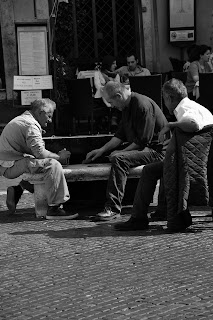“A way a lone a last a long
the…. riverrun past Eve’s and Adam’s, from swerve of shore to bend of bay
brings us by a commodious vicus of recirculation to Howth Castle and Environs.”
The last unfinished
sentence of James Joyce’s Finnegan’s Wake merges into the first uninitiated
sentence thereby establishing the premise and purpose of a recurrent dream,
with all its layers of distortion in human behaviour, desires, beliefs and expression.
The only constant is a carefully constructed almost classical architecture, is
the room, the street, the city, as counterpoise to otherwise fleeting images of
self and language and to the old adage which states, “No man steps in the same
river twice".
Finnegan’s Wake, named for
a remembered tune of Joyce’s youth about a drunken bricklayer who fell to his
death but who at his wake was splashed with whiskey and startling to life
exclaimed ‘Soul to the devil, do ye think I’m dead?’, is a resurrection
odyssey.
Finnegan’s Wake is the night to Ulysses’ day.
You might think from the
above, if you were being generous, gentile, and game, that I have read FW
but confess I must, I have not, at least not beyond about the first and last few pages and the iconic final chapter of Book I where two washerwomen across the
Liffey discuss the sexual failings of the publican and dreamer Humphrey
Chimpden Earwicker and where Joyce manages to include the names of more than
500 rivers. I found Finnegan’s Wake, even with the best will in the world, impenetrable,
as is often the case when you try to walk in someone else’s dream.
The departure in 20th
century literature that FW represented opened as many doors as it closed and in
a strange way, and this brings me shortly to the Via Frattina in Rome, echoed
the response in the early 1500’s to another dream sequence book which also invented
and reinvented language (this time Latinate Italian as the core rather than
Hiberno-English) called Hypnerotomachia Poliphili by Francesco Colonna, and
first published in 1499.
Title Page of English Translation of Hypnerotomachia 1599
For Poliphilo (translated
as either ‘friend of many things’ or ‘city lover’) read HC Earwicker and their
respective dream transits through the night are similar in pursuit of their
respective lovers Polia (many things) and Anna Livia Plurabelle (many beauties).
Poliphilo wakes up just as he is to take Polia in his arms and Earwicker fails
in trying to have intercourse with Anna Livia.
Was Joyce aware of the Hypnerotomachia?
This is uncertain. I have searched many of the references to Joyce’s voluminous
notebooks and not yet found a concrete connection or even a ‘commodious vicus
of recirculation.’ And yet I feel there must be and that that connection must
be linked to Joyce’s unhappy stay in Rome between 1906-1907. A recent personal
trip to Rome and the happenchance stumbling-upon a sculptural representation
from the Hypnerotomachia got me wandering or wondering, for sometimes in my
case they are one in the same.
Via Frattina is a narrow
road that links the Via del Corso and the southern end of the Piazza Spangna
where the Palazzo di Propaganda Fide (an extraterritorial property of the Holy
See which houses the Congregation for the Propagation of the Catholic Faith in
non-Catholic countries) and the church of Sant Andrea delle Fratte are situated. Sant
Andrea, dedicated to St Andrew of Scotland, was first built in 1192 was called infra hortes or ‘between orchards’.
Later it became known as Fratte, an old roman word for woods.
Across from the hotel where
I was staying was No: 52 Via Frattina. On the wall is a plaque, which
acknowledges that this was the address that Joyce first stayed during his short
sojourn in Rome between August 1906 and March 1907. Joyce then 24 arrived in Rome, already fluent
in French and Italian and able to read Ibsen in the original Norwegian. Typical
however of his previous stay in Trieste Joyce was continually penniless, was forever
leaving debts and was drinking heavily. So heavily that his landlord Signor
Dufour was to evict Joyce, Nora and baby Giorgio out onto the Via Frattina on the 1st
December 1906 having taking a severe dislike to his late-night revelries.
Via Frattina at Dusk looking east towards the Spanish Steps.
Joyce's digs are in house to right of picture at No 52.
Leaving Austrian Trieste Joyce
had obtained a position in the private German bank of Nast-Kolb &
Schumacher, which was located in the Palazzo Marignoli further down the Corso (but
entered from no 87 Via S. Caudio), and moved his family into Via Frattina. To
all intents and purposes Joyce appears to have hated the city ('Rome reminds me of a man who lives by
exhibiting to travellers his grandmother’s corpse’), the bank clerks he
worked with ('When I
enter the bank in the morning I wait for someone to announce something about
either his cazzo, culo or coglioni’), the postal service (‘insolent whores’) and in a later
letter was to call his stay in Rome a ‘folly’.
And yet the city must have
influenced his subsequent writing and this brings me to the link to the
Hypnerotomachia.
I suppose if you were to
discuss Joyce’s religious affiliation you probably best describe him as a
‘lapsed drunk’ whereas in contrast Brendan Behan was faithful to the end. And
yet the catholic tradition kept a hold on him, a fascination. On his evening and
night-time perambulations (Joyce claimed he used drinking as a form of family
planning!) he would have walked on many occasions past the church of Santa
Maria Sopra Minerva and I am certain that its history would have pulled him in.
Tombstone of Cardinal Juan de Torquemada
Sancta Maria sopra Minerva
The church was commissioned
about 1275 by the Dominican Order on the site of the former Temple of Isis (it
should have been called Sancta Maria supra or sopra Isis and not attributed to
Minerva as the former temple to Minerva was on what is now the Piazza Collegio
Romano). In 1628 the Congregation of the Holy Office responsible for the
Inquisition was moved to the attached Convent of Minerva and it was here that
Galileo was tried for heresy and forced on pain of torture to ‘abjure, curse
and detest’ his defence of Copernican astronomical heliocentrism. Indeed
Cardinal Juan de Torquemada, the uncle of the infamous Grand Inquisitor in
Spain Tomás de Torquemada, both Dominicans, is buried in a small side chapel.
Once back into to the light
however, and onto the Piazza Minerva, it is the 1667 Bernini sculpture of an
elephant, surmounted by an Egyptian obelisk that captures one's attention. The
obelisk, found in 1665, is one of the many pairs of Egyptian obelisks erected
at the Temple of Isis (Obeliscus Isei Campensis) in the first to third centuries.
Elephant & Obelisk Piazza Minerva 1667
The Minerva obelisk is attributed to Pharaoh Apries (Wahibre Haaibre) the 4th
pharaoh (589 -570 BCE) of the 26th Dynasty. Apries was the Egyptian
monarch who failed to prevent the Babylonians under Nebuchadnezzar sacking
Jerusalem and carrying off the Jewish people into captivity. The obelisk was
originally erected at Sais on the lower Nile Delta, where there was a famous
medical school for women attached to the Temple of Isis in the 6th
century BCE, and moved to Rome by the Emperor Diocletian (retired 1 May 305).
Bernini’s sculpture is particularly fascinating as it is almost an exact imitation of one of the woodcuts in the
Hypnerotomachia Poliphili from 150 years earlier.
The smiling elephant is
thought to be about to defecate and in a strange way it reminded me of one of
Joyce’s other literary influences, Alfred Jarry the inventor of so-called Pataphysics.
Jarry a French absurdist/surrealist contemporary of Joyce who died from drugs
and alcohol use at the age of 34 in November 1907 (shortly after Joyce had
retreated from Rome back to Trieste), was the author of yet another
hallucinatory voyage, his post-mortem published Exploits and Opinions of Dr. Faustroll, Pataphysician (Paris instead of Dublin, Faustroll instead of Earwicker),
whose infamous play Ubu Roi opens with the word “Merdre!” And whose last wish
was for a toothpick! I cannot but
surmise than Joyce, with a greater curiosity than mine must in addition to Jarry's Faustroll also have embraced
the elephant and later the dream journey of Poliphilo.
For my own responses all I
could think of as I recirculated round the Piazza Minerva statue on
an October afternoon was of a childhood joke: What do you give an elephant with
diarrhoea? Answer: Plenty of Room.
Finnegan’s Wake is a bit
like that Bernini elephant, and like that childhood elephant joke it must be
given plenty of room, a Lucretian swerve as it were, avoiding like any good
dream lover real engagement lest you fall into the void.











































